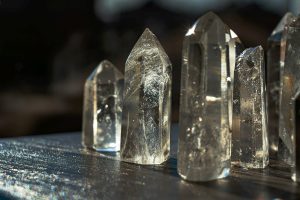WHAT IS QUARTZ CRYSTAL?

Image: Quartz crystal (Photo by Castorly Stock)
Quartz crystal, a remarkable mineral with a rich geological history, is composed of silicon and oxygen atoms arranged in a repetitive pattern. Renowned for its unique properties, quartz is prized for its use in various industries, from electronics to metaphysics. In the realm of technology, quartz crystals serve a crucial role in timekeeping devices, such as quartz watches. The piezoelectric nature of quartz allows it to vibrate at a precise frequency when an electric field is applied, ensuring accurate timekeeping. This application has made quartz a fundamental component in modern timepieces. Beyond their technological significance, quartz crystals have captivated individuals for centuries due to their metaphysical properties. Many believe in the crystal’s ability to amplify energy, clear negativity, and enhance spiritual well-being. Quartz is often used in meditation practices and alternative healing methods. Geologically, quartz crystals can be found in a variety of environments, from igneous rocks like granite to sedimentary formations. Their diverse formations, including points, clusters, and geodes, showcase the mineral’s adaptability and aesthetic appeal. Whether admired for its scientific contributions or embraced for its metaphysical allure, quartz crystal stands as a multifaceted mineral that continues to leave an indelible mark on various aspects of human life and understanding.
USE OF QUARTZ IN WATCH

Image: Quartz wrist watch
Quartz is commonly used in watch dials, not as a material for the dial itself but for its role in the timekeeping mechanism. Quartz watches are known for their accuracy and reliability, thanks to the use of a quartz crystal oscillator. Inside a quartz watch, there is a tiny integrated circuit that includes a quartz crystal. When an electric current is applied to the quartz crystal, it vibrates at a precise frequency, usually 32,768 times per second. This consistent vibration serves as a highly accurate timekeeping reference. The integrated circuit counts these vibrations and converts them into regular timekeeping pulses, ensuring that the watch keeps time with remarkable precision. The term “quartz” on a watch dial often indicates that the timekeeping mechanism is powered by a quartz crystal. Quartz watches have become widely popular due to their accuracy, low maintenance, and affordability compared to mechanical watches. The use of quartz crystals has revolutionized the watch industry, providing a reliable and efficient means of timekeeping for everyday use. Quartz is widely utilized in watches for its exceptional timekeeping properties. In a quartz watch, a small battery sends an electric current through a quartz crystal, typically cut in the shape of a tiny tuning fork. This quartz crystal oscillates at a consistent frequency (usually 32,768 times per second), creating a precise timekeeping reference. The vibrations of the quartz crystal are harnessed by an integrated circuit, which divides the oscillations into regular, accurate pulses. These pulses are then used to drive the stepping motor, which powers the movement of the watch’s hands. The use of quartz in this timekeeping mechanism provides several advantages:
- Accuracy: Quartz watches are known for their accuracy, often surpassing the precision of mechanical watches. The stable oscillations of the quartz crystal contribute to reliable timekeeping.
- Low Maintenance: Unlike mechanical watches, quartz watches require minimal maintenance. They do not rely on intricate gears and springs, reducing the need for regular servicing.
- Affordability: Quartz watches are generally more affordable to produce than their mechanical counterparts. This affordability has contributed to the widespread availability and popularity of quartz timepieces.
- Durability: Quartz watches are often more resilient to external factors such as shocks and magnetic fields, making them suitable for various environments and activities.
- Battery-Powered: Quartz watches are typically powered by small batteries that can last for an extended period, often several years. This eliminates the need for frequent winding, as seen in mechanical watches.
The use of quartz in watches has revolutionized the watchmaking industry, providing consumers with accurate, reliable, and cost-effective timepieces. Whether in casual everyday watches or high-end designs, quartz continues to play a pivotal role in meeting the demands of a diverse and global market.
NIKOLA TESLA’s RESEARCH ON QUARTZ

Image: Nicola Tesla doing research with quartz.
Nicola Tesla, a pioneering scientist and inventor of the late 19th and early 20th centuries, made noteworthy contributions to the understanding and utilization of quartz crystals. While Tesla is widely recognized for his work in electricity and magnetism, his experiments with quartz reveal another facet of his scientific curiosity. One of Tesla’s notable endeavors involved the exploration of the piezoelectric properties of quartz crystals. He discovered that when subjected to mechanical stress, quartz crystals generate an electric charge. This revelation played a crucial role in his development of various inventions, including the creation of highly sensitive crystal oscillators. Tesla’s quartz crystal oscillators became essential components in his radio frequency devices. These oscillators provided stable and precise frequencies, contributing significantly to the advancement of radio technology. Tesla’s innovations with quartz crystals laid the groundwork for modern communication systems and electronic devices. Moreover, Tesla’s interest in the vibrational qualities of quartz extended into his exploration of resonant frequencies. He experimented with mechanical oscillators that could produce intense vibrations, leading to his fascination with the resonance of quartz crystals and their potential applications in energy transmission. While Tesla’s direct influence on quartz research may not be as well documented as his other contributions, his work with crystals undoubtedly played a role in shaping the landscape of modern technology. Today, the legacy of Nicola Tesla lives on through the ongoing research and discoveries inspired by his innovative spirit, with quartz crystals continuing to be a subject of scientific exploration in various fields.
To know more about Nicola Tesla’s research on quartz.
A DEEP CONNECTION OF QUARTZ WITH HINDUISM

Image: Sphatik shivling (Shiv Lingam made of clear quartz)
A quartz The Shiva Lingam is a sacred and revered symbol in Hinduism, representing the union of Lord Shiva and Goddess Shakti. The term “Shiva Lingam” originates from the Sanskrit words “Shiva,” the god of destruction and transformation, and “Lingam,” meaning symbol or representation. The quartz variant of the Shiva Lingam holds special significance due to its material properties and spiritual symbolism. The Shiva Lingam is traditionally associated with the worship of Lord Shiva, one of the principal deities in Hinduism. Devotees believe that the Lingam embodies divine cosmic energy, and its worship fosters spiritual growth, purification, and the realization of the ultimate truth. Quartz Shiva lingams are distinctive for their composition, as quartz is a crystalline mineral known for its clarity, energy amplification, and purifying properties. The use of quartz in crafting Shiva lingams adds a layer of symbolism, connecting the divine energy represented by the lingam with the inherent qualities of the crystal. Devotees often choose quartz Shiva Lingams for their spiritual practices, believing that the quartz amplifies the sacred energy and intentions during worship. The translucent nature of quartz also adds an aesthetic dimension, allowing devotees to witness the play of light within the crystal during rituals. The worship of the quartz Shiva Lingam typically involves rituals, prayers, and offerings conducted in temples or personal shrines. Pilgrims often seek Shiva Lingams during their travels to sacred sites, believing that the presence of the Lingam enhances the spiritual experience and facilitates a deeper connection with the divine. Quartz Shiva Lingams serve as tangible reminders of the profound spiritual teachings within Hinduism, emphasizing the union of opposites and the transcendence of duality. The crystal’s purity and clarity mirror the aspirational qualities of spiritual seekers on their journey towards enlightenment, making the quartz Shiva Lingam a revered and cherished symbol in the rich tapestry of Hindu religious practices.
CONCLUSION
While Nicola Tesla is primarily renowned for his ground-breaking work in electricity and magnetism, his research and experimentation with quartz crystals marked a significant but relatively less-explored aspect of his contributions. Tesla’s fascination with the piezoelectric properties of quartz led to the development of crystal oscillators, which played a crucial role in the advancement of radio technology. His innovative spirit extended to the vibrational qualities of quartz, contributing to his exploration of resonant frequencies and their potential applications in energy transmission. In conclusion, Tesla’s research on quartz crystals was a testament to his multidisciplinary approach to science and technology. Although not as extensively documented as some of his other achievements, his insights into the properties of quartz influenced the development of crucial components in modern communication systems. The legacy of Tesla’s work with quartz continues to resonate in contemporary technological landscapes, underscoring the breadth and depth of his visionary contributions to scientific inquiry.








0 Comments